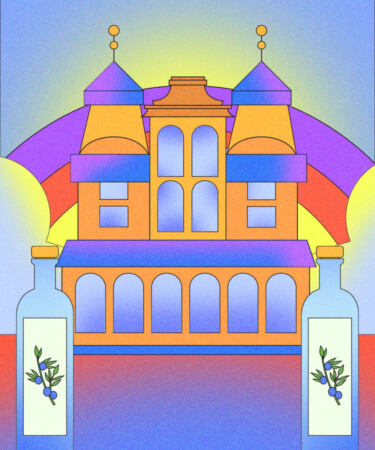During periods in history when water wasn’t always safe to drink, some societies around the world considered alcohol to be a perfectly good alternative for quenching thirst. And as one would expect, this belief had quite an impact on the people living in them. In the 18th century specifically, when many British citizens were turning to gin and beer as substitutes for H20, alcoholism was rampant. That’s why in the late 1730s through the early 1750s, the British government passed a series of Gin Acts that imposed a mandatory license to sell gin, as well as a tax on sales. As gin was thought to have medicinal properties at the time, this welcomed the opening of small, pharmacy-like storefronts called gin shops or chemist’s shops where drinkers could purchase the spirit. But while these establishments allowed gin lovers to snag their fix, they provided no place to consume it.
Fast forward to the 1820s, and the first “public houses” — homes that had been converted to bars that sold beer — were established. In response, gin distillers set out to open their own pubs, which were aptly dubbed by the public as “gin palaces.”
The Rise
In 1830s London, the Industrial Revolution was in full swing. Queen Victoria was in power, and Charles Dickens himself was knocking back gin while writing “Oliver Twist.” Gin palaces soon became a welcome addition to the social atmosphere of the bustling city. As per law at the time, these “palaces” had to offer ale and wine to remain operational, though both played second fiddle to the main attraction. These swanky bars sought to change the seedy perception of gin by offering a cozy, luxurious, well-lit place where people of all walks of life could mingle and enjoy the spirit.
The “palace” title was earned by not only the massive size of these establishments, but the decor. Ornate chandeliers hung in every room. Etched glass windows adorned the walls, and mosaics, mirrors, and hand-carved mahogany paneling found their place on every polished bar top. And behind the bar often stood an all-female staff, gussied up to the nines to pour gin from one of the many barrels behind them.
These barrels were usually labeled in a similar fashion to the modern chalkboard menus at today’s taprooms, complete with humorous, tongue-in-cheek names scribbled across them. Dickens recalled difficulty deciding between “The Cream of the Valley, The No Mistake, The Good for Mixing, The Real Knock-me-down, and a dozen other, equally inviting and wholesome liqueurs,” in his collection of stories “Sketches by Boz.”
Dickens also wrote about how the palaces’ lavish nature was juxtaposed against the shabby streets they occupied. He famously noted that gin palaces were “perfectly dazzling when contrasted with the darkness and dirt we have just left.” And dazzling as they may have been, the guise of gin palaces was, in truth, a bunch of smoke and mirrors.
The Demise
Despite their spike through the 1840s — at their peak, London alone was home to roughly 5,000 gin palaces — the 1850s saw the decline of gin palaces. Like a wolf in a Versace dress, the decor of these gin palaces functioned as a distraction from their unruly, piss-drunk patrons. When people were drinking gin by the pint, it didn’t take long for palace-goers to get out of hand: Fistfights were a nightly occurrence, and even young children were pulling up to the bar and getting served spirits to their hearts’ content. The spaces were quickly transformed from hedonistic hideaways to, quite frankly, utter sh*t shows.
Over time, the palaces gave way to less chaotic yet still debaucherous pubs, either shuttering all together or transitioning into pubs themselves as beer rose in popularity. While some of these palaces-turned-pubs still exist, complete with fully restored Victorian interiors — visit Northern Ireland’s Crown Liquor Saloon or London’s Princess Victoria Pub to see one for yourself — history’s gin palaces are no more.
